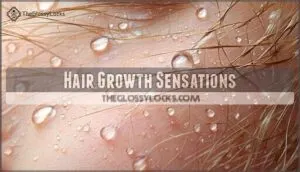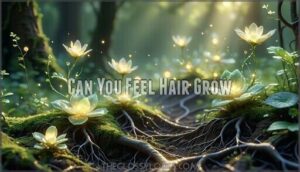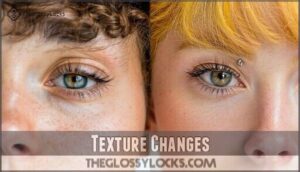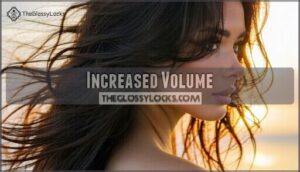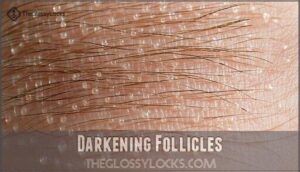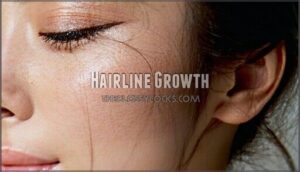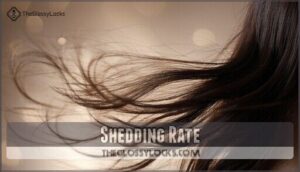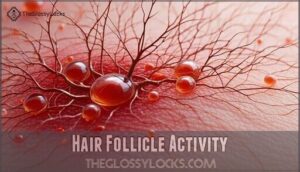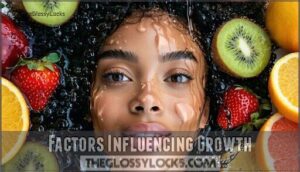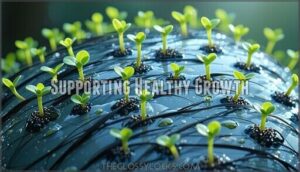This site is supported by our readers. We may earn a commission, at no cost to you, if you purchase through links.
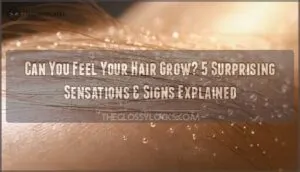 You can’t actually feel your hair grow—it’s too slow and subtle for your nerves to detect.
You can’t actually feel your hair grow—it’s too slow and subtle for your nerves to detect.
However, sensations like tingling, itching, or even a crawling feeling on your scalp might make you wonder.
These sensations don’t prove your hair’s actively growing, but they can indicate increased blood flow or follicle activity.
Think of it like planting seeds in a garden—you can’t see the roots forming, but things are happening beneath the surface.
If you notice new baby hairs, a thicker texture, or a fuller hairline, those are solid signs of growth.
Curious about boosting those follicles? Stay tuned for tips!
Table Of Contents
- Key Takeaways
- Hair Growth Sensations
- Can You Feel Hair Grow
- Signs of New Growth
- Hair Growth Indicators
- Factors Influencing Growth
- Supporting Healthy Growth
- Frequently Asked Questions (FAQs)
- Can a person feel their hair growing?
- Should you be able to feel your hair?
- How do you tell if you have hair regrowth?
- Can you feel a hair system on your head?
- Can hair growth cause headaches?
- Does stress affect hair growing speed?
- Can seasonal changes impact hair growth?
- Is hair growth linked to genetics?
- Can certain diets inhibit hair growth?
- How does hormonal imbalance affect hair growth?
- Conclusion
Key Takeaways
- You can’t feel your hair grow, but tingling or itching might signal increased blood flow or follicle activity.
- Baby hairs, a thicker texture, or a fuller hairline are signs your hair is actively growing.
- A healthy diet, balanced hydration, and regular scalp massages support hair growth effectively.
- Stress, hormones, and poor nutrition can slow hair growth, so manage these factors for better results.
Hair Growth Sensations
You’ll notice unique sensations on your scalp as new hair emerges, including tingling, mild itchiness, or subtle prickly feelings that signal increased blood flow to your follicles.
Tingling and prickly sensations on your scalp are exciting signs of increased blood flow and healthy hair growth awakening your follicles.
These physical cues, often overlooked in daily life, actually indicate healthy follicular activity as your hair progresses through its natural growth cycle, which can include sensations that signal increased blood flow.
Tingling Scalp
That tingling scalp sensation you’re experiencing might actually be a sign of hair growth.
During periods of active follicle activity, increased circulation boosts nerve stimulation, creating a distinct scalp tingling feeling.
Your tingling may indicate:
- Improved blood flow delivering nutrients to hair follicles
- Active growth phase (anagen) stimulating nerve endings
- Product sensitivities triggering a positive response
Many users of MSM supplements specifically report this sensation as hair growth perception intensifies, suggesting your scalp’s heightened awareness of the regrowth process.
Itchiness
While tingling can signal new growth, that persistent itch you feel might also be your hair sprouting!
Itchiness often accompanies hair growth as blood flow increases to nourish your follicles.
| Itchiness Cause | What It Means | Relief Method |
|---|---|---|
| Hair Growth | Normal scalp activity | Gentle massage |
| Product Sensitivity | Allergic reaction | Switch products |
| Scalp Inflammation | Possible dermatitis | Medicated shampoo |
| Dryness | Lack of moisture | Hydrating oils |
| Fungal Issues | Requires treatment | Antifungal solutions |
Don’t scratch vigorously—you’ll damage those precious new strands! Hair growth and scalp inflammation are key considerations when addressing itchiness, and finding the right relief method is crucial.
Prickly Sensation
While itching might come and go, that prickly sensation on your scalp is a more definitive regrowth indicator.
Similar to feeling stubble after shaving, this post-loss sensation occurs when new hairs push through follicles.
The scalp sensitivity you’re experiencing isn’t imaginary—it’s actual follicle emergence happening! Many people describe this hair root sensation as similar to tiny pins gently poking through fabric.
Your hair follicle stimulation is simply signaling the exciting beginning of your sensory hair experience, which can be a remarkable sensory hair experience.
Crawly Sensations
During your hair growth journey, you might experience crawly sensations that feel like something moving under your scalp.
These formication-like feelings aren’t always related to actual hair growth, though some report them with supplement use.
- Inner scalp movement sensations often increase after taking MSM and vitamins
- Yoga scalp relief exercises can help alleviate uncomfortable crawling sensations
- A slightly sore scalp might accompany these sensations during active growth phases
Can You Feel Hair Grow
Many people wonder if growth perception is actually possible regarding your hair.
While you mightn’t feel individual strands lengthening, your scalp can experience unique sensations during active growth phases.
| Sensation | Explanation | Common Occurrence |
|---|---|---|
| Tingling | Increased blood flow to follicles | Morning or after washing |
| Mild Itching | Follicle stimulation and renewal | During growth spurts |
| Crawling | Nerve stimulation from active follicles | After using growth products |
| Pressure | Hair follicle repair activity | During recovery from damage |
The truth is, hair growth awareness varies widely between individuals.
The gradual process happens too slowly (about 1 cm monthly) for nerve stimulation to be consistently noticeable.
After injury, regrowth can take years, with scalp sensitivity changes occurring throughout healing.
You’re more likely to notice these sensations if you’ve recently experienced hair loss or are actively treating scalp issues.
An itchy scalp could indicate new hair emerging.
Signs of New Growth
You’ll notice several subtle indicators when your hair begins its new growth cycle, including fine baby hairs along the hairline and a slight change in texture where emerging strands feel softer than established ones.
These visible signs, often accompanied by decreased shedding and increased volume in previously thinning areas, confirm that your follicles are actively producing healthy new hair, which can be identified by a slight change in texture where emerging strands feel softer than established ones, and this is a sign of new growth cycle.
Texture Changes
When new hair emerges, you’ll notice four distinct texture changes that signal healthy growth:
- Baby hairs often feel softer and more delicate than your existing strands
- Temporary texture differences may appear coarser or curlier before normalizing
- Follicle influence determines whether new growth matches your natural pattern
- Environmental impact can alter how these strands feel as they mature
This hair growth sensation of changing texture is your scalp’s way of celebrating revival! It indicates that your hair is undergoing a significant transformation, leading to a more vibrant and natural look.
Increased Volume
A noticeable increase in volume often signals successful hair growth cycles.
You’ll typically spot this change when styling becomes easier or your hair suddenly appears fuller.
To further support this growth, consider how nutrient-rich foods impact hair health.
| Growth Stage | Volume Indicators | Sensation | Maintenance Tips |
|---|---|---|---|
| Early | Slight lift at roots | Minimal scalp tingling | Gentle brushing |
| Developing | Increased density | Moderate follicle stimulation | Volumizing shampoo |
| Established | Fuller appearance | Reduced shedding | Avoid heavy products |
| Mature | Complete thickness increase | Normal scalp feeling | Regular trims |
The different stages of hair growth have distinct characteristics, including changes in volume and sensation, which can guide maintenance tips to support healthy hair development.
Darkening Follicles
When your hair follicles begin to produce more pigment, they often appear darker—a promising sign of new hair growth.
This darkening indicates enhanced nutrition reaching your follicles, stimulating melanin increase and improved follicle health.
You’ll notice these dark hair strands emerging from previously inactive areas, signaling renewed hair follicle activity.
While this process varies between individuals, darkening follicles remain one of the most reliable visual indicators that your hair growth journey is progressing well.
Hairline Growth
While darkening follicles signal activity beneath the surface, your hairline offers the most visible evidence of new hair growth.
Watch for fine, soft "baby hairs" emerging along your temples or widows peak, you’ll often notice these delicate strands catching light differently than mature hair.
Many people report a subtle scalp tingling feeling accompanying this temple regrowth, density improvement typically starts with these wispy frontline soldiers—a promising sign your hairline shape is being restored, with new hair growth being the ultimate goal.
Hair Growth Indicators
You’ll notice several measurable indicators that reveal active hair growth cycles, from decreased shedding to increased scalp sensitivity.
Your hair’s health communicates through these specific signals, including shinier strands and heightened follicle activity, which collectively confirm your hair care efforts are working effectively.
Shedding Rate
In spite of what you might think, shedding hair is actually a normal sign of healthy growth cycles. Your normal shedding rate can indicate whether new hair is developing properly.
- 50-100 hairs shed daily during regular activities
- 10-20 strands lost while brushing
- 50-80 strands released during washing
- 20-30 hairs naturally shed without external factors
Excessive shedding beyond these numbers could signal problems, while reduced shedding often indicates successful growth phases. For curly hair, it may seem like more shedding occurs due to trapped shed strands.
Sensitivity in Scalp
When your scalp becomes increasingly sensitive, it often signals active hair follicle stimulation beneath the surface.
You might notice a distinct scalp tingling feeling as blood circulation increases around the root.
This sensitivity isn’t always uncomfortable—many describe it as a subtle awareness of nerve fibers responding to growth.
Healthy follicles naturally create these sensations, though product sensitivity or scalp inflammation can sometimes mimic these growth indicators.
Shiny Strong Strands
Beyond that tingling in your scalp lies another telltale sign: shiny strong strands that signal healthy growth. When your hair gleams with natural luster, it’s visual confirmation of proper nutrient absorption throughout all growth stages.
Here are 5 strength factors behind that healthy shine:
- Higher keratin production
- Improved blood circulation
- Balanced oil production
- Enhanced cuticle alignment
- Ideal moisture retention
These visual indicators, unlike hair growth sensations or nerve fiber responses, provide tangible evidence your hair care routine is working, showcasing proper nutrient absorption.
Hair Follicle Activity
Your hair follicles engage in an intricate cycle of activity beneath the surface of your scalp.
When these tiny structures receive proper Blood Circulation and Nutrient Absorption, you’ll notice thicker, darker strands emerging.
The Growth Stages become more apparent as Follicle Health improves.
You might even experience subtle hair growth sensations – an indication of active Follicle Regeneration.
This biological process is why some people report feeling movement or tingling during intense growth periods.
Factors Influencing Growth
Your hair’s growth is influenced by several key factors that you can actually control, including nutrition, hydration, stress levels, and proper scalp care.
You’ll notice significant improvements in growth rate and hair health when you address these elements through consistent habits like eating protein-rich foods, staying well-hydrated, managing stress effectively, and maintaining regular scalp exfoliation to achieve proper scalp care.
Nutrition and Hair
Nourishing your hair from within plays a critical role in healthy growth.
Your hair’s health directly reflects your diet—lacking essential nutrients like protein, iron, and zinc can lead to thinning or brittleness.
Vitamins for hair growth (A, C, D, E, and B complex) support follicle function, while omega-3 fatty acids maintain shine.
Think of your diet as your hair’s fuel source—what you eat today appears in your strands tomorrow, highlighting the importance of a balanced diet for healthy growth.
Hydration and Scalp
While proper nutrition feeds your hair from within, your water intake directly impacts scalp health.
Think of your scalp as a garden—it needs regular watering to thrive.
Proper hydration enhances product absorption and prevents that uncomfortable dry scalp feeling.
Regular scalp massages increase blood flow, creating those pleasant scalp sensations that signal growth.
When hydrated, your follicles respond better to treatments, creating an ideal environment for new strands to emerge, which is crucial for maintaining a healthy scalp.
Stress Management
Stress management plays a vital role in hair growth. Stress and hair are tightly linked; too much stress can halt growth or cause shedding.
To support your scalp, there are several strategies that can help.
- Practice mindful meditation to reduce cortisol.
- Prioritize quality sleep for repair and balance.
These habits can be complemented by staying active, as exercise equals less stress, and exploring calming hobbies, like gardening.
Enjoy deep breaths; your scalp will thank you.
Scalp Care and Exfoliation
A healthy scalp sets the stage for thriving hair.
Exfoliation benefits include cleaner hair follicles and scalp blood flow for better growth.
Gently mix a DIY scrub (sea salt, coconut oil) or choose a product suited for you.
Consider exploring options for homemade scalp scrubs to find the perfect blend.
Pair this with a scalp massage for circulation boost, easing hair itching while encouraging strong, balanced growth.
| Exfoliation Method | Key Ingredient | Benefit |
|---|---|---|
| DIY Scrub | Sea Salt & Coconut | Removes buildup, nourishes |
| Chemical Exfoliant | Salicylic Acid | Deep cleanses, unclogs pores |
| Scalp Massage Oils | Jojoba or Prebiotics | Soothes, boosts circulation |
Supporting Healthy Growth
You can’t control how fast your hair grows, but you can support its health with smart care.
Eating nutrient-rich foods, massaging your scalp, and avoiding heat damage are simple ways to keep your strands strong and thriving.
Balanced Diet
A balanced diet fuels hair growth like a well-tuned engine.
Load up on protein, hair vitamins, and minerals—think of eggs, spinach, and salmon as your go-to. Hydration keeps your scalp happy, while the right supplements fill nutritional gaps.
Skip fad diets; they’ll starve your strands. Instead, enjoy balanced meals packed with nutrients, and watch your hair thrive.
Incorporating omega-3 fatty acids from foods like salmon and walnuts can further protect hair follicles and support overall hair growth.
Regular Scalp Massage
In the context of scalp care, regular scalp massage can promote hair growth by improving circulation and delivering nutrients to hair follicles.
Try these tips:
- Use gentle circular motion Massage Techniques.
- Incorporate oils (like coconut) for added Oil Benefits.
- Experiment with Massage Tools for ease.
- Focus on Frequency Matters—2-3 times weekly supports growth.
- Enjoy relaxation while stimulating hair growth!
Many people find success using a quality massage oil.
Avoiding Heat Styling
Ditching your curling iron can save your strands! Heatless styling methods, like braids or rollers, protect your natural texture from heat damage.
Opt for protective hairstyles and product alternatives to reduce styling damage and hair breakage.
Embrace your natural beauty, and give hair treatments a boost by letting your locks recover, and your hair will thank you for using heatless styling methods!
Gentle Hair Care Practices
Swapping heat tools for Protective Hairstyles or gentle Wide-tooth Combs minimizes stress on your hair.
Use Sulfate-free Shampoos to retain your hair’s natural oils, and try Soft Towel-drying to prevent hair breakage.
Consider gentle cleansing options for healthier hair.
Silk Pillowcases reduce friction, protecting hair texture during sleep.
Careful, consistent hair care preserves strands, encouraging hair growth while keeping your locks shiny and healthy with Sulfate-free Shampoos.
Frequently Asked Questions (FAQs)
Can a person feel their hair growing?
Hair grows about 1 cm a month, but you can’t actually feel it.
Any tingling or itching on your scalp is likely from increased blood flow or follicle activity, not the physical hair growth process.
Should you be able to feel your hair?
You can’t physically feel your hair itself because it’s made of keratin, which lacks nerves.
However, you might notice tingling, itching, or soreness on your scalp, signaling follicle activity or hair growth processes.
How do you tell if you have hair regrowth?
About 90% of your hair is growing at any time.
Spot regrowth by noticing "baby hairs" near your scalp, reduced shedding, or thicker, darker strands.
A tingly scalp and tiny flyaways often signal progress.
Can you feel a hair system on your head?
You’ll likely feel a light pressure or snug fit when wearing a hair system, but it shouldn’t be uncomfortable.
If it’s properly applied, it blends seamlessly, and you might even forget it’s there!
Can hair growth cause headaches?
About 50% of people claim to feel sensations during hair growth, but headaches aren’t directly caused by it.
If you’re experiencing scalp tenderness or tingling, it’s likely increased circulation, not hair pulling strings up top!
Does stress affect hair growing speed?
Stress can mess with your hair’s growth by pushing it into a resting phase, slowing it down.
It’s like hitting pause, but with patience, proper care, and less stress, growth can bounce back.
Can seasonal changes impact hair growth?
Just like trees shed leaves in autumn, your hair growth may slow in winter due to reduced sunlight and vitamin D.
Spring and summer, however, can boost growth, thanks to better circulation and longer days.
Is hair growth linked to genetics?
Hair growth is absolutely linked to genetics.
Your DNA determines factors like growth rate, thickness, and texture.
While you can’t change your genes, healthy habits and care can still make a noticeable difference.
Can certain diets inhibit hair growth?
Certain diets can slow hair growth, especially those low in protein, iron, or zinc.
Your hair thrives on nutrients, so skipping balanced meals might leave your scalp sending SOS signals, craving the essentials it needs!
How does hormonal imbalance affect hair growth?
Hormonal imbalances disrupt your hair growth cycle, pushing strands into a resting phase prematurely.
This can trigger shedding, thinning, or even bald patches.
Balancing hormones, like with thyroid care or stress reduction, can help with hair growth.
Conclusion
Think of hair growth like watching grass grow—slow, steady, and mostly undetectable.
While you can’t feel your hair grow directly, sensations like tingling or itching might reflect increased scalp activity.
Recognizing signs like new baby hairs, thicker texture, or a fuller hairline gives you clues that growth is happening.
By supporting healthy habits like scalp care, balanced nutrition, and less heat styling, you’ll encourage those strands to thrive, even if you can’t feel it happening, through healthy habits.

